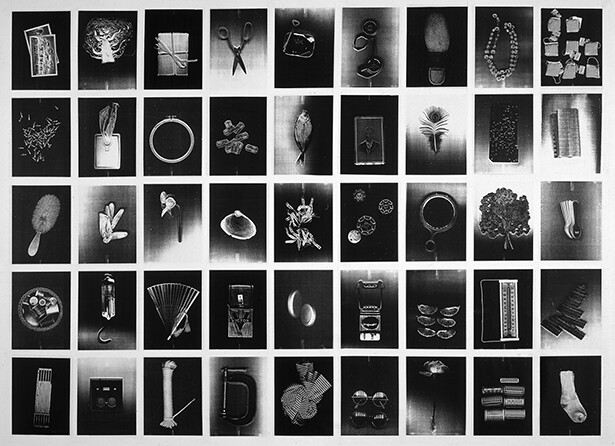February 25–April 24, 2016
Arcadia University Art Gallery
450 S. Easton Rd.
Glenside, PA 19038
T 215 572 2131 (2133)
Arcadia University Art Gallery is pleased to present Pati Hill: Photocopier, A Survey of Prints and Books (1974–83). Featuring over one hundred works on paper, this exhibition reconsiders the hybrid practice of Pati Hill (1921–2014), a little-known American writer who, at the age of 53, pioneered the use of the copier as a printmaking tool as well as a means to “bring artists and writers together.” Hill’s fascination with the machine, which she called “a found instrument—a saxophone without directions,” transformed her work at a moment of promise for a technology she would continue to explore for nearly forty years.
One of the few artists to remain committed to a medium whose creative possibilities were subsumed by the digital processes it helped to propel, Hill employed the copier as both a collaborator and a muse. The inspired writing of her 1979 book, Letters to Jill, a catalogue and some notes on copying, serves as a primary resource for the show. The following description that appears on the front of the announcement of her 1978 exhibition at Franklin Furnace is also telling:
“PHOTOCOPIER
This stocky, unrevealing box stands 3 ft. high without stockings or feet and lights up like a Xmas tree no matter what I show it.
It repeats my words perfectly as many times as I ask it to, but when I show it a hair curler it hands me back a space ship, and when I show it the inside of a straw hat it describes the eerie joys of a descent into a volcano.”
The objects Hill chose to copy, which she consistently printed at life-scale, are visually transformed yet faithfully convey their intrinsic properties, as well as those of the machine. She learned to favor the rich blacks of the IBM Copier II as well as its flaws and distancing effects, which gave the subjects Hill isolated on its platen the potential to be read as symbols. Thanks to a chance encounter on a transatlantic flight with Charles Eames in 1977, she secured a two-and-a-half year loan of this particular model, which IBM delivered to her home in Stonington, Conn. Direct access to the machine made it possible for her to copy a dead swan, a process that took five weeks and resulted in a suite of 32 captioned prints that suggest a myth of metamorphosis. Hill also used the copier to modify appropriated photographs, which she sequenced into the pictorial narratives that comprise Men and Women in Sleeping Cars (1979) and extend the chilly prose of Impossible Dreams, her 1976 novel of familial dissolution.
Informed by a hieroglyphic symbol language she developed, much of her work from this period sought to fuse text and image into “something other than either.” Hill used the copier as a vehicle for these experiments by applying the formats of the book and the exhibition as opposed to collage. By 1979, her interest in testing the limits of the medium inspired her to “photocopy Versailles,” an expansive project that would occupy her for the next 20 years and lead her to work with colored toner, frottage, and photogravure. A selection of initial attempts from this effort—copies of paving stones, an espaliered pear tree, and other materials gathered from the grounds—are included in the exhibition along with a sampling of her publications.
Pati Hill: Photocopier will be accompanied by a catalog and series of public programs that commence with a lecture by exhibition curator Richard Torchia at 6:30pm in the University Commons Great Room preceding the 7:30pm opening reception on February 25.
Additional events will continue through April 24, including a lecture on March 17 at 6:30pm by Michelle Cotton, director of the Bonner Kunstverien (Bonn, Germany). Cotton, who has contributed an essay to the catalog, will discuss Xerography, the international survey exhibition she curated for Firstsite, (Colchester, Essex, UK) to honor the 75th anniversary of Chester Carlson’s 1938 invention of the photocopier.
Pati Hill: Photocopier has been supported by The Pew Center for Arts & Heritage.


